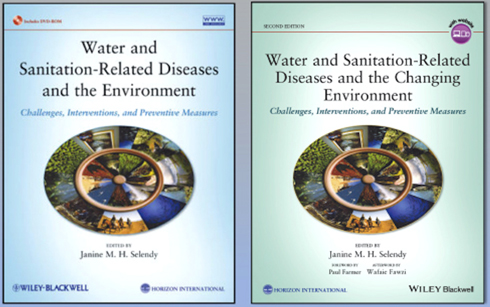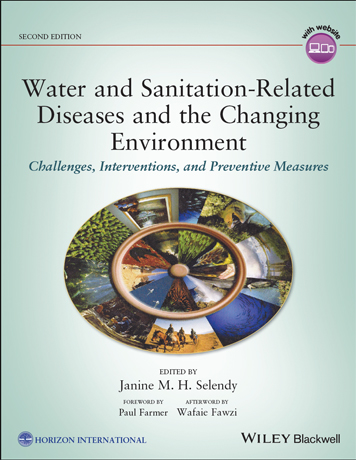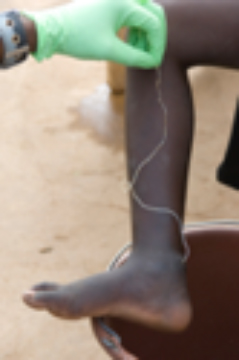Navigation
"Water and Sanitation-Related Diseases and the Changing Environment: Challenges, Interventions, and Preventive Measures" Volume 2 Is Now Available
- Agriculture
- books
- Climate change
- environmental engineering
- environmental health
- Epidemiology
- Global Health
- Harvard Medical School
- Harvard T. H. Chan School of Public Health
- medical anthropology
- medicine
- nutrition
- Paul Farmer
- population
- public health
- Air Pollution
- Biodiversity
- Desertification
- Global Climate Change
- Global Health
- Industry
- News and Special Reports
- Oceans, Coral Reefs
- Pollution
- Population
- Public Health
- Rivers
- Sanitation
- Toxic Chemicals
- Transportation
- Waste Management
- Water
- Water and Sanitation
The Authoritative Guide to Water and Sanitation Related Diseases, with Many Revised, Updated and New Chapters, Accompanies the First Edition
Augmenting authoritative interdisciplinary coverage in the first edition, this new edition of Water and Sanitation-Related Diseases and the Changing Environment expands upon the significance of the changing environment to disease vectors, food systems and nutrition, and population, and the importance of ecosystem health to human health. Many chapters stand as they are in first edition to which readers are referred, and which are not included in this volume.
 Two Volumes
Two Volumes
Written by 75 authorities from the fields of climate change, epidemiology, environmental health, environmental engineering, global health, medicine, medical anthropology, nutrition, population, and public health.
The following is an excerpt from what Dr. Paul Farmer writes in his Foreword to the new volume, Water and Sanitation-Related Diseases and the Changing Environment: Challenges, Interventions, and Preventive Measures:
“The work of experienced scholars, public‐health advocates, and implementers, this new edition of Water and Sanitation‐Related Diseases and the Changing Environment offers a thorough review of some of the ranking problems of our time. Taken individually, these chapters constitute a critical compendium of ongoing debates among experts and a concise summary of more settled matters. But editor Janine Selendy has also woven these diverse chapters—which include highly focused considerations of specific waterborne illnesses and more broad‐ranging matters from climate change to technological innovation—into a powerful and hefty manual to guide collective action going forward…. It will be an authoritative reference for practitioners and trainees to deliver on the promise of water, sanitation, and health for all.”
Paul Farmer, MD, PhD Kolokotrones University Professor, Harvard University, Chair, Department of Global Health and Social Medicine, Harvard Medical School Chief, Division of Global Health Equity, Brigham and Women’s Hospital, Co‐founder, Partners In Health
The new volume Water and Sanitation-Related Diseases and the Changing Environment: Challenges, Interventions, and Preventive Measures is, as was the First Edition, a Wiley-Blackwell publication in collaboration with Horizon International compiled and edited by Janine M. H. Selendy.
Recognizing the consequences of climate change now evident and that need to be anticipated in order to minimize foreseeable and unforeseen consequences, climate change is factored into the 2ndEdition’s updated and revised chapters and in new chapters.
 Cover
Cover
Wiley provides excerpts:
Chapter 1 (PDF) available at https://media.wiley.com/product_data/excerpt/13/11194162/1119416213-13.pdf
Table of Contents (PDF) available at https://media.wiley.com/product_data/excerpt/13/11194162/1119416213-28.pdf
Index (PDF) available at https://media.wiley.com/product_data/excerpt/13/11194162/1119416213-79.pdf
As Wafaie Fawzi and Chelsey R Canavan, write in this excerpt from their Afterword, “Addressing Water and Sanitation-Related Diseases is Fundamental to Global Health and Sustainable Development:”
“These books emphasize the linkages between water and sanitation with a range of infectious diseases, food systems and malnutrition, and water pollutants. Throughout the text, we see how each of these elements interrelates with climate change, extreme weather, and ecosystem changes. Climate change is already impacting food and water systems globally, threatening our ability to provide safe and adequate food and water for the world’s growing and urbanizing population. Agricultural production systems are under increased pressure to feed a hungry planet that is also suffering from water pollution and other forms of environmental degradation.
 Agricultural Burning: FIGURE 4.5 Agricultural burning in about 4 million square kilometers throughout central Africa. Fires burning in the southern region of the Democratic Republic of the Congo, Zambia and Angola. Actively burning areas outlined in red. Photo from the NASA’s Aqua satellite June 3, 2016. NASA, NOAA, and the U.S. Department of Defense. https://www.nasa.gov/image-feature/goddard/2016/fires-in-angola-zambia-d.... From Chapter 4: “Water, Food and the Environment,” by Robert Wyman and Guigui Yao.
Agricultural Burning: FIGURE 4.5 Agricultural burning in about 4 million square kilometers throughout central Africa. Fires burning in the southern region of the Democratic Republic of the Congo, Zambia and Angola. Actively burning areas outlined in red. Photo from the NASA’s Aqua satellite June 3, 2016. NASA, NOAA, and the U.S. Department of Defense. https://www.nasa.gov/image-feature/goddard/2016/fires-in-angola-zambia-d.... From Chapter 4: “Water, Food and the Environment,” by Robert Wyman and Guigui Yao.
Agricultural burning in about 4 million square kilometers throughout central Africa. Fires burning in the southern region of the Democratic Republic of the Congo, Zambia and Angola. Actively burning areas outlined in red. Photo from the NASA’s Aqua satellite June 3, 2016. NASA, NOAA, and the U.S. Department of Defense. https://www.nasa.gov/image-feature/goddard/2016/fires-in-angola-zambia-democratic-republic-of-the-congo. In Chapter 4, “Water, Food and the Environment,” by Robert Wyman and Guigui Yao.
"The intertwined nature of human health, water, food, and natural ecosystems is not to be overlooked. The framers and signatories to the Sustainable Development Goals understood this dynamic: 'Access to safe water and sanitation and sound management of freshwater ecosystems are essential to human health and to environmental sustainability and economic prosperity.' Progress in one area—hunger, sustainable communities, climate action—have implications for others—water and sanitation, health and wellbeing, poverty, and inequality.
“The authors of these books have highlighted conditions that must be met to achieve the Sustainable Development Goal to “ensure availability and sustainable management of water and sanitation for all.”
“The task at hand is urgent but it is not insurmountable. Julio Frenk and Octavio Gómez-Dantés present one example of preventative measures taken in Mexico that successfully improved child health in their chapter on “Extending the Right to Health Care and Improving Child Survival in Mexico.”

FIGURE 22.1 Emerging Guinea worm. Savelugu, northern Ghana.: Patient with a Guinea worm emerging, at the Savelugu Case Containment Center. (Photo credit: The Carter Center/Louise Gubb.)
“Donald Hopkins and Ernesto Ruiz-Tiben describe the effort to eradicate guinea worm, and how this ambitious task has gone from possible to probable to imminent. The success stories in this book demonstrate that, often, we know what works. And when we fail, the scientific, civic, and activists communities are capable of coming together to overcome obstacles.
"The human right to water and sanitation also serves to align various stakeholder groups. Commitment from world leaders must be matched by that from national and local decision-makers, donors and funding agencies, and researchers and program implementers alike. Protection of ecosystems and prevention of pollutants involves collaboration among leaders and participants at global, national and local levels. In several chapters of these books, the authors have reminded us of “the necessity of community engagement as a requisite for success.
Wafaie Fawzi, MBBS, MPH, MS, Drph, Former Chair Department of Global Health and Population, Richard Saltonstall Professor Of Population Sciences, Professor Of Nutrition, Epidemiology, And Global Health, Harvard T.H. Chan School Of Public Health
Canavan, Chelsey, Program Manager, Nutrition and Global Health Program,Harvard T.H. Chan School of Public Health
From the Back Cover
The Authoritative Guide to Water and Sanitation Related Diseases, with Many Revised, Updated and New Chapters, Accompanies the First Edition
Augmenting authoritative interdisciplinary coverage in the first edition, this new edition of Water and Sanitation-Related Diseases and the Changing Environment expands upon the significance of the changing environment to disease vectors, food systems and nutrition, and population, and the importance of ecosystem health to human health. Many chapters stand as they are in first edition to which readers are referred, and which are not included in this volume.
The books were written by 75 experts from the fields of climate change, environmental engineering, environmental health, epidemiology, food and agriculture, global health, medicine, medical anthropology, nutrition, population, and public health. The authors discuss international conditions responsible for diseases that result from a lack of safe water and sanitation including pollutants and other interconnected environmental factors. The authors discuss the pathogens, vectors, and their biology, morbidity and mortality that result from a lack of safe water and sanitation. The text also explores the distribution of these diseases and the conditions that must be met to reduce or eliminate them. The authors cover access to and maintenance of clean water, sanitation and hygiene (WASH) and guidelines for the safe use of wastewater, excreta, and grey water, plus examples of solutions. This important guide:
· Offers an understanding of the interconnection among many water-related diseases, sanitation, and hygiene (WASH) factors.
· Provides an appreciation of the concerns and most recent solutions addressed from an international perspective.
· Provides strategies for securing safe water, sanitation, and hygiene.
· Is filled with compelling examples of successful interventions and how they were accomplished, such as the near eradication of Guinea worm disease.
Written for students and professionals in public health and medicine, chemical and environmental engineering, and international affairs, and for decision-makers and corporate leaders, this new edition of Water and Sanitation-Related Diseases and the Changing Environment is a comprehensive resource that complements the first edition.
Search
Latest articles
Agriculture
- World Water Week: Healthy ecosystems essential to human health: from coronavirus to malnutrition Online session Wednesday 24 August 17:00-18:20
- World Water Week: Healthy ecosystems essential to human health: from coronavirus to malnutrition Online session Wednesday 24 August 17:00-18:20
Air Pollution
- "Water and Sanitation-Related Diseases and the Changing Environment: Challenges, Interventions, and Preventive Measures" Volume 2 Is Now Available
- Global Innovation Exchange Co-Created by Horizon International, USAID, Bill and Melinda Gates Foundation and Others
Biodiversity
- It is time for international mobilization against climate change
- World Water Week: Healthy ecosystems essential to human health: from coronavirus to malnutrition Online session Wednesday 24 August 17:00-18:20
Desertification
- World Water Week: Healthy ecosystems essential to human health: from coronavirus to malnutrition Online session Wednesday 24 August 17:00-18:20
- UN Food Systems Summit Receives Over 1,200 Ideas to Help Meet Sustainable Development Goals
Endangered Species
- Mangrove Action Project Collaborates to Restore and Preserve Mangrove Ecosystems
- Coral Research in Palau offers a “Glimmer of Hope”
Energy
- Global Innovation Exchange Co-Created by Horizon International, USAID, Bill and Melinda Gates Foundation and Others
- Wildlife Preservation in Southeast Nova Scotia
Exhibits
- Global Innovation Exchange Co-Created by Horizon International, USAID, Bill and Melinda Gates Foundation and Others
- Coral Reefs
Forests
- NASA Satellites Reveal Major Shifts in Global Freshwater Updated June 2020
- Global Innovation Exchange Co-Created by Horizon International, USAID, Bill and Melinda Gates Foundation and Others
Global Climate Change
- It is time for international mobilization against climate change
- It is time for international mobilization against climate change
Global Health
- World Water Week: Healthy ecosystems essential to human health: from coronavirus to malnutrition Online session Wednesday 24 August 17:00-18:20
- More than 400 schoolgirls, family and teachers rescued from Afghanistan by small coalition
Industry
- "Water and Sanitation-Related Diseases and the Changing Environment: Challenges, Interventions, and Preventive Measures" Volume 2 Is Now Available
- Global Innovation Exchange Co-Created by Horizon International, USAID, Bill and Melinda Gates Foundation and Others
Natural Disaster Relief
- STOP ATTACKS ON HEALTH CARE IN UKRAINE
- Global Innovation Exchange Co-Created by Horizon International, USAID, Bill and Melinda Gates Foundation and Others
News and Special Reports
- World Water Week: Healthy ecosystems essential to human health: from coronavirus to malnutrition Online session Wednesday 24 August 17:00-18:20
- STOP ATTACKS ON HEALTH CARE IN UKRAINE
Oceans, Coral Reefs
- World Water Week: Healthy ecosystems essential to human health: from coronavirus to malnutrition Online session Wednesday 24 August 17:00-18:20
- Mangrove Action Project Collaborates to Restore and Preserve Mangrove Ecosystems
Pollution
- Zakaria Ouedraogo of Burkina Faso Produces Film “Nzoue Fiyen: Water Not Drinkable”
- "Water and Sanitation-Related Diseases and the Changing Environment: Challenges, Interventions, and Preventive Measures" Volume 2 Is Now Available
Population
- "Water and Sanitation-Related Diseases and the Changing Environment: Challenges, Interventions, and Preventive Measures" Volume 2 Is Now Available
- "Water and Sanitation-Related Diseases and the Changing Environment: Challenges, Interventions, and Preventive Measures" Volume 2 Is Now Available
Public Health
- Honouring the visionary behind India’s sanitation revolution
- Honouring the visionary behind India’s sanitation revolution
Rivers
- World Water Week: Healthy ecosystems essential to human health: from coronavirus to malnutrition Online session Wednesday 24 August 17:00-18:20
- Mangrove Action Project Collaborates to Restore and Preserve Mangrove Ecosystems
Sanitation
- Honouring the visionary behind India’s sanitation revolution
- Honouring the visionary behind India’s sanitation revolution
Toxic Chemicals
- "Water and Sanitation-Related Diseases and the Changing Environment: Challenges, Interventions, and Preventive Measures" Volume 2 Is Now Available
- Actions to Prevent Polluted Drinking Water in the United States
Transportation
- "Water and Sanitation-Related Diseases and the Changing Environment: Challenges, Interventions, and Preventive Measures" Volume 2 Is Now Available
- Urbanization Provides Opportunities for Transition to a Green Economy, Says New Report
Waste Management
- Honouring the visionary behind India’s sanitation revolution
- Honouring the visionary behind India’s sanitation revolution
Water
- Honouring the visionary behind India’s sanitation revolution
- Honouring the visionary behind India’s sanitation revolution
Water and Sanitation
- Honouring the visionary behind India’s sanitation revolution
- Honouring the visionary behind India’s sanitation revolution

